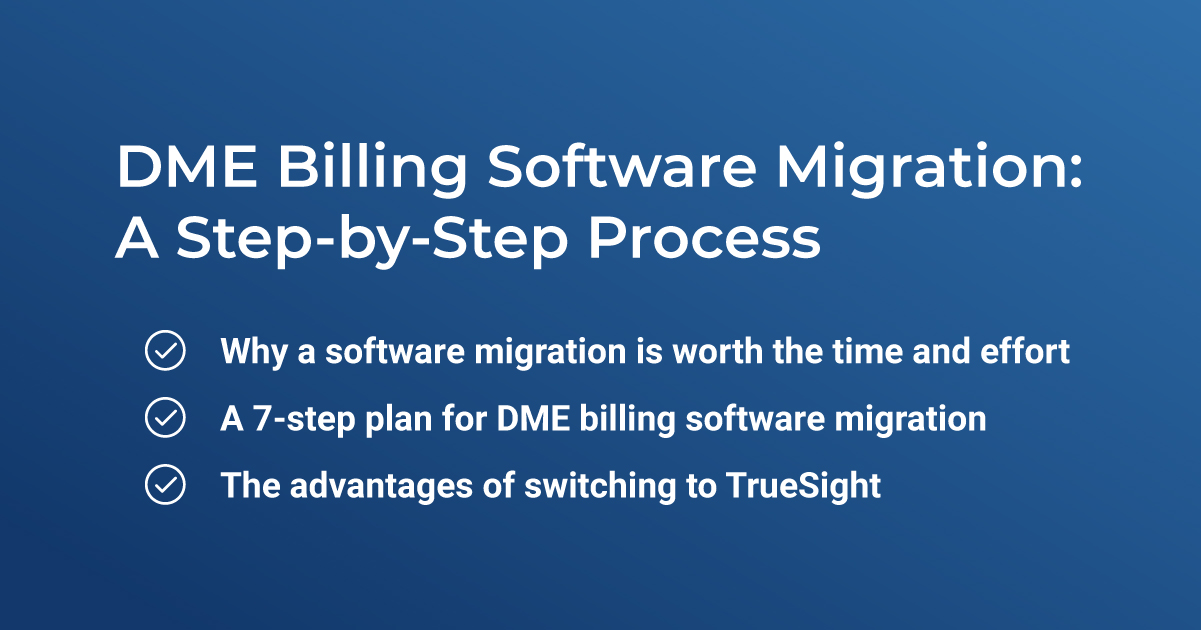IN THIS ARTICLE:
- Why a software migration is worth the time and effort
- A 7-step plan for DME billing software migration
- The advantages of switching to TrueSight
Is a DME Billing Software Migration Really Worth It?
There’s an unfortunate fact about our field: many of the tools that dominate the industry are outdated — and designed to keep you using them indefinitely. While many of us recognize this, fewer of us are willing to take the necessary steps to implement a new system.
A full-scale DME billing software migration can be a complicated process. Leading SaaS options would have you believe it’s not worth the effort. The question is, are they right?
Here at TrueSight, we set out to redefine the narrative of our industry by proving that better tools are both available and worth the effort to implement. While a migration to new software may take some time, the simple fact is that the benefits — streamlined operations, more accurate documentation, healthier revenue cycles, and thousands of dollars in savings — are well worth your investment.
With a proper plan and the right components in place, a software migration can be a relatively smooth operation. Here are a few proven steps to guide your process:
Your Software Migration in 7 Steps:
1. The Planning Phase
The first step to a successful migration is careful planning. Begin by establishing some clear objectives — first the necessities, then the desires — and follow up by studying the feature sets of both the old and new software. This is where you’ll identify the key differences and how they will affect your final workflow.
With these items in mind, create a detailed plan and timeline, ensuring the dedicated migration team has a capable project manager and the involvement of department heads. These leaders will validate the new software features as they relate to their respective operations to ensure no features are missing on launch day.
2. Data Preparation and Cleaning
Before the migration itself can begin, it’s critical to conduct a comprehensive data audit. This involves reviewing and analyzing all the data that will be carried over and identifying any issues, such as varied data types or differences in required fields between systems.
The data may need to be cleaned and standardized to ensure nothing is dropped during migration. Though this process can be tedious, doing it properly ensures minimized risk and a smoother transition to start your team off on the right foot with its new software.
3. Training and Support for Staff
Speaking of your team, your staff will need to get familiar with all their new tools before the go-live date arrives. At this stage, you may want to develop a basic training program for all the projected software users, providing ample resources to ease them into the transition with all the information they need.
While ongoing training sessions and refresher courses can be scheduled as needed, TrueSight also offers a comprehensive user manual available to your team at any time, which is absolutely free.
4. The Pilot Migration
Before the migration itself is executed, it’s best to run a pilot with a small set of data. This provides visibility into the functionality and performance of the new system in a controlled environment. It’s vital that department heads get to see this step in action, as this information will be crucial for validating the system, gathering feedback, and making any necessary adjustments.
5. The Full Migration
Once the pilot phase is complete and all adjustments have been made to your satisfaction, it’s finally time to proceed with the full data migration according to the plan that was established in the second step. If any issues or questions arise during the process, TrueSight’s experts will be there to help.
6. Post-Migration Necessities
After migration, a thorough system check will need to be conducted to ensure all data is valid and all features are functioning as expected. Authorized users will have a chance to test-run the software in its entirety, provide feedback, and request any improvements that need to be made until the system is fully optimized.
7. Making the Most of Your New Software
Let’s not forget why you chose to undertake a full DME billing software migration: to equip your team with newer, better, smarter features and optimize your operations.
With TrueSight, your team can expect:
Opportunistic learning from real-time feedback. TrueSight’s unique connection directly to the clearinghouse highlights errors on claims in real time rather than the outdated overnight batch format. This ensures faster, more accurate claims and more digestible learning.
A streamlined user experience and claims lifecycle. TrueSight is the DME billing platform designed to adapt to you rather than the other way around. Configure modules to your liking and streamline your claims lifecycle through cutting-edge automation.
Ongoing support from DME experts you trust. TrueSight is the only billing platform powered by Medbill. That means your experience is backed by the support of professionals with collective decades of experience in your industry.
Trust TrueSight for Your DME Billing Software Migration
The truth is that DME billing software migration is a big step to take for your business. When you choose to switch to TrueSight, however, the results are worth every minute and every penny. Save your business thousands of dollars and hours of time with a platform that prioritizes you — no more per-patient fees, no more overnight batch runs, and no more outdated tools. Empower your operations with TrueSight, the only software powered by Medbill.
Ready to take the leap? Contact TrueSight for your FREE DEMO today.






